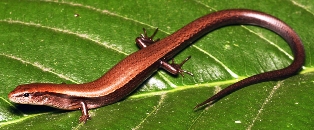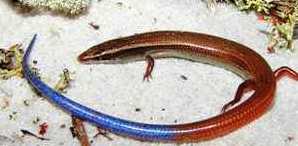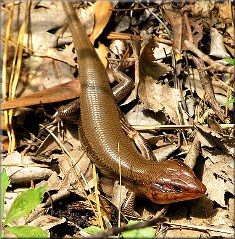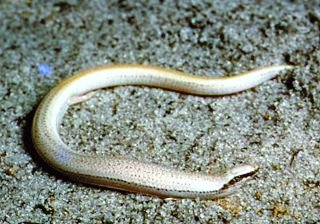Discover Florida Nature
It's time to explore the natural Florida


|
|
|
|
|
Smooth, sleek, and shiny are the adjectives used to describe the healthy
skink. All the species of skinks found in Florida prowl on the ground
for small insects, although the larger species also climb trees and
wooden structures. The skink family is a large group and this lizard is
found on all continents. Skinks are not easy to catch! Larger skinks may
try to bite but a skink will rarely break the skin. Many skinks have
blue tails. This may be part of a defense strategy called defective
coloration. The blue color is supposed to serve as a warning to
predators that the skink is poisonous and there is some actual evidence
that the blue tails are poisonous if eaten. Ground
Skink- Ground skinks are small, slender lizards with long tails
and short legs. They range from golden brown to almost black in
coloration but are most often coppery brown with a darker stripe running
along each side of the body. The belly is white or yellowish. Unlike
many other lizards in our region, ground skinks virtually never climb.
Rather than running on their tiny legs, ground skinks use their slender
bodies to wriggle or "swim" through leaf litter or loose soil, often
disappearing in a flash as soon as they are discovered. Ground skinks
prey on tiny insects, spiders, and other invertebrates. Female ground
skinks lay clutches of several eggs in moist soil or rotten logs during
the summer. It is suspected that ground skinks may lay several clutches
per season. Ground
Skink- Ground skinks are small, slender lizards with long tails
and short legs. They range from golden brown to almost black in
coloration but are most often coppery brown with a darker stripe running
along each side of the body. The belly is white or yellowish. Unlike
many other lizards in our region, ground skinks virtually never climb.
Rather than running on their tiny legs, ground skinks use their slender
bodies to wriggle or "swim" through leaf litter or loose soil, often
disappearing in a flash as soon as they are discovered. Ground skinks
prey on tiny insects, spiders, and other invertebrates. Female ground
skinks lay clutches of several eggs in moist soil or rotten logs during
the summer. It is suspected that ground skinks may lay several clutches
per season.  Mole
Skinks- Mole skinks are small, slender lizards with long tails
and short legs. They range from grayish to brown in background color
with two light stripes running along each side of their body and a red
or orange tail that does not fade with age. This is the only lizard in
Florida with a red tail and this character easily distinguishes them
from the similar ground skink. True to their name, these lizards are
adept at burrowing and prefer areas of loose sandy soil. They generally
prefer hotter and drier habitats than the similar ground skink and are
often found beneath leaf litter, logs, boards, and other cover objects.
Mole skinks are perhaps most common in sandy scrub and coastal dune
habitats and often inhabit offshore islands. Rather than running on
their tiny legs, mole skinks use their slender bodies to wriggle or
"swim" through sand or loose soil, often disappearing in a flash as soon
as they are discovered. Mole skinks are so secretive that much remains
to be learned about their habits and behavior. The
Key West Mole Skink is
currently endangered. Mole
Skinks- Mole skinks are small, slender lizards with long tails
and short legs. They range from grayish to brown in background color
with two light stripes running along each side of their body and a red
or orange tail that does not fade with age. This is the only lizard in
Florida with a red tail and this character easily distinguishes them
from the similar ground skink. True to their name, these lizards are
adept at burrowing and prefer areas of loose sandy soil. They generally
prefer hotter and drier habitats than the similar ground skink and are
often found beneath leaf litter, logs, boards, and other cover objects.
Mole skinks are perhaps most common in sandy scrub and coastal dune
habitats and often inhabit offshore islands. Rather than running on
their tiny legs, mole skinks use their slender bodies to wriggle or
"swim" through sand or loose soil, often disappearing in a flash as soon
as they are discovered. Mole skinks are so secretive that much remains
to be learned about their habits and behavior. The
Key West Mole Skink is
currently endangered. Broad
Headed Skink- Broadheaded skinks have long been called
scorpions by uninformed rural southerners who believe that they are
venomous. Males during the breeding season have bright orange head
coloration, and the heads of large males are proportionally much bigger
than those of females. It stays red throughout the breeding period in
May and June, but then fades by July. Broadheaded skinks are active
foragers that move through the habitat looking for small animal prey
although they occasionally eat fruit such as blackberries and grapes.
While foraging they flick their tongues out frequently to locate scents
of prey. They eat a wide range of small invertebrates, especially
insects, many of which are found hidden in or under logs or surface
litter on the forest floor. The lizards also tongue-flick to detect the
presence of predators and to gather information about other members of
their own species. From the scent of another lizard, broadheaded skinks
can tell whether the other lizard belongs to the same species, its sex,
its reproductive condition, and whether or not it is a familiar
individual. Broad
Headed Skink- Broadheaded skinks have long been called
scorpions by uninformed rural southerners who believe that they are
venomous. Males during the breeding season have bright orange head
coloration, and the heads of large males are proportionally much bigger
than those of females. It stays red throughout the breeding period in
May and June, but then fades by July. Broadheaded skinks are active
foragers that move through the habitat looking for small animal prey
although they occasionally eat fruit such as blackberries and grapes.
While foraging they flick their tongues out frequently to locate scents
of prey. They eat a wide range of small invertebrates, especially
insects, many of which are found hidden in or under logs or surface
litter on the forest floor. The lizards also tongue-flick to detect the
presence of predators and to gather information about other members of
their own species. From the scent of another lizard, broadheaded skinks
can tell whether the other lizard belongs to the same species, its sex,
its reproductive condition, and whether or not it is a familiar
individual.  Florida
Sand Skink- One of the most highly adapted scrub creatures, the
4" sand skink occurs nowhere in the world except six counties in central
Florida. Like most members of the skink family, the sand skink is a
smooth-scaled, shiny lizard that likes to stay out of sight. The sand
skink is on the U.S. list of
Threatened species. They are vulnerable to extinction because of
habitat loss as more and more of the Florida scrub is cleared for
development. A unique lizard adapted to an underground existence, the
sand skink measures 4 to 5 inches in length and has a gray to tan color.
The sand skink has a wedge-shaped head, a partially countersunk lower
jaw, body grooves into which the forelegs can be folded, and small eyes
which have transparent windows in the lower lids. These features enable
the lizard to swim beneath the surface of loose sand. The diet of the
Florida Mole Skink consists of surface-dwelling invertebrates, including
beetle larvae, and termites. Florida
Sand Skink- One of the most highly adapted scrub creatures, the
4" sand skink occurs nowhere in the world except six counties in central
Florida. Like most members of the skink family, the sand skink is a
smooth-scaled, shiny lizard that likes to stay out of sight. The sand
skink is on the U.S. list of
Threatened species. They are vulnerable to extinction because of
habitat loss as more and more of the Florida scrub is cleared for
development. A unique lizard adapted to an underground existence, the
sand skink measures 4 to 5 inches in length and has a gray to tan color.
The sand skink has a wedge-shaped head, a partially countersunk lower
jaw, body grooves into which the forelegs can be folded, and small eyes
which have transparent windows in the lower lids. These features enable
the lizard to swim beneath the surface of loose sand. The diet of the
Florida Mole Skink consists of surface-dwelling invertebrates, including
beetle larvae, and termites.
|
|
|
Advertise | Privacy Statement | Dog Encyclopedia | Video |Contact | Alaska Nature |
|